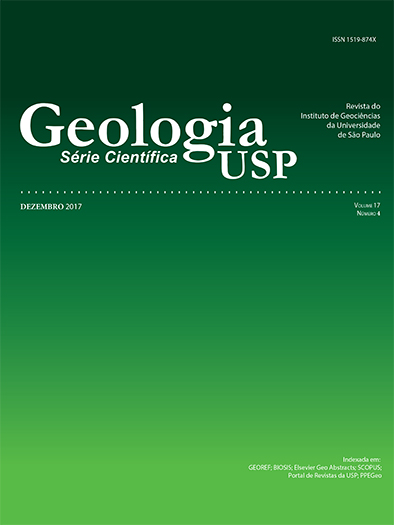Emplacement, Metamorphism and nature of the Água Azul do Norte amphibolites, Carajás Province
DOI:
https://doi.org/10.11606/issn.2316-9095.v17-441Keywords:
Amphibolite, Geochemistry, Thermobarometry, Archean, Carajás.Abstract
The metamafic bodies identified in the Água Azul do Norte area, located in the south-central portion of the Carajás Domain, crosscut the tonalite-trondhjemite-granodiorite (TTG) basement and encompass two varieties: (i) actinolite amphibolite, an extensive elongated body (~ 17 km long) with N-S orientation and inflection to NE and essentially composed of plagioclase and amphibole, with relics of igneous pyroxene and plagioclase, defining a subophitic texture; and (ii) diopside amphibolite, with occurrence restricted to the extreme east of the area, outcropping as small lenticular anastomosed bodies of NW-SE orientation. These bodies have a protolith with composition compatible with tholeiitic basalts and ratios of incompatible high field strength elements (HFSE) that suggest source derived from primitive mantle, with significant changes in the magma composition due to interaction with the continental crust and/or subcontinental lithosphere. The chemical-mineralogical and textural evidences indicate that the protolith of actinolite amphibolite underwent deformation in the submagmatic stage and later deformation in solid state at shallow depths. In contrast, the diopside amphibolite was submitted to ductile deformation regime in relatively high depths. The emplacement and deformation of these rocks would be related to D2 moment, which the TTG crust of Água Azul area was submitted during heterogeneous deformation with accommodation of dextra and sinistral shear zones. The metamorphic path of the actinolite amphibolite reveals isothermal decompression (metamorphic peak at 2.7 kbar and 430ºC; and retrometamorphic equilibrium at 1.2 kbar and 425ºC), associated with its exhumation and/or emplacement of leucogranite bodies, whereas the diopside amphibolite indicates metamorphism under amphibolite facies conditions in intermediate crustal level and environment of relatively cold crust (5 kbar; 540ºC). These data indicate distinct metamorphic evolution for the amphibolites besides exhumation and exposure of relatively deep crustal levels in Água Azul do Norte (~ 9 – 16 km).Downloads
Download data is not yet available.
Downloads
Published
2018-02-20
Issue
Section
Articles
License
Authors who publish in this journal shall comply with the following terms:
- Authors keep their copyright and grant to Geologia USP: Série Científica the right of first publication, with the paper under the Creative Commons BY-NC-SA license (summary of the license: https://creativecommons.org/licenses/by-nc-sa/4.0 | full text of the license: https://creativecommons.org/licenses/by-nc-sa/4.0/legalcode) that allows the non-commercial sharing of the paper and granting the proper copyrights of the first publication in this journal.
- Authors are authorized to take additional contracts separately, for non-exclusive distribution of the version of the paper published in this journal (publish in institutional repository or as a book chapter), granting the proper copyrights of first publication in this journal.
- Authors are allowed and encouraged to publish and distribute their paper online (in institutional repositories or their personal page) at any point before or during the editorial process, since this can generate productive changes as well as increase the impact and citation of the published paper (See The effect of Open Access and downloads on citation impact).
How to Cite
Souza, D. B. de, Oliveira, D. C. de, Monteiro, L. V. S., Gabriel, E. O., & Marangoanha, B. (2018). Emplacement, Metamorphism and nature of the Água Azul do Norte amphibolites, Carajás Province. Geologia USP. Série Científica, 17(4), 99-123. https://doi.org/10.11606/issn.2316-9095.v17-441





